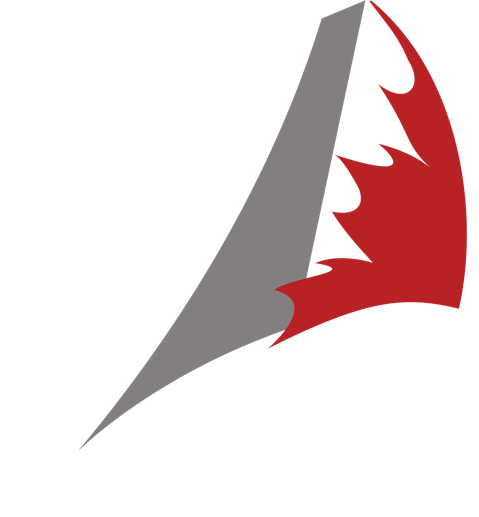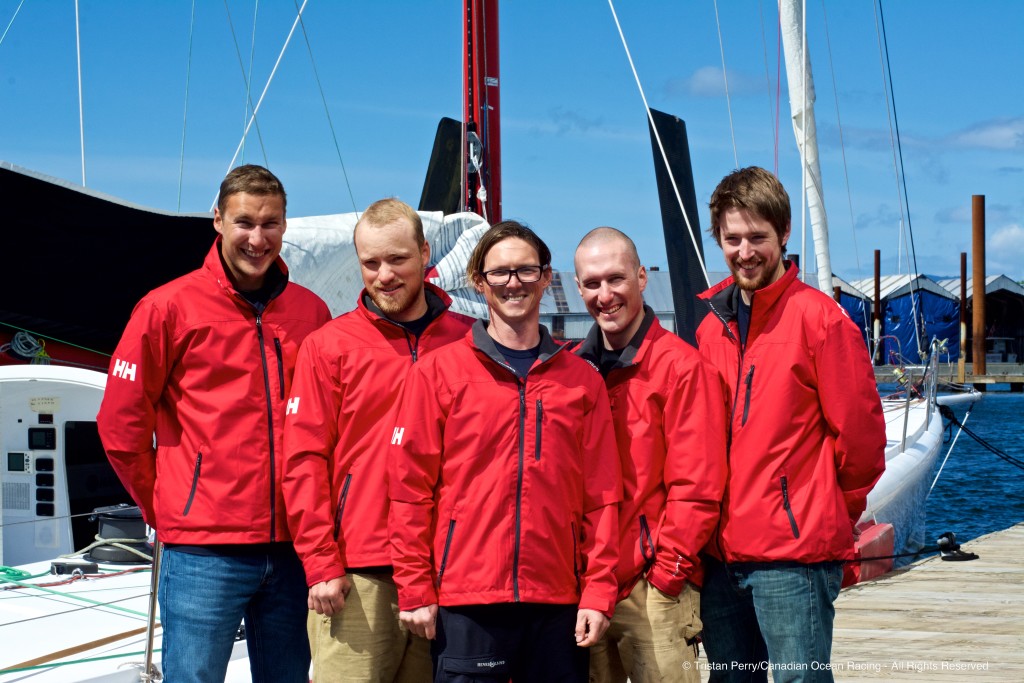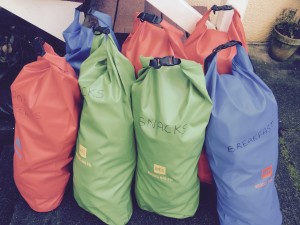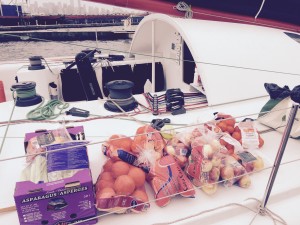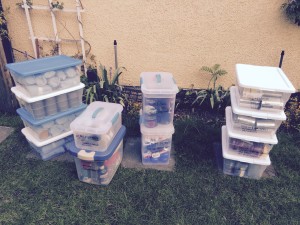Canadian Ocean Racing has wrapped up the refit of O Canada and is now on the team’s tour around North America. Four Aspiring Offshore Athletes (AOAs) from across the country join Skipper Eric Holden on a journey from Vancouver to Toronto via the Panama Canal.
The AOA program launches with the team’s first #CORTOUR, in which the team will log over 8000 nM training with Eric Holden on Open 60 O Canada. COR’s journey to Toronto will take 2 months and will culminate at the team’s appearance at the Pan Am Games plus local events.
Track the team’s current progress:
Meet the Team
Left to Right: Sandy Macpherson, Morgen Watson, Eric Holden, Daniel Gaw, Liam Johnston
Life #onbored
Offshore sailing is not just a sport, it’s a lifestyle. A lifestyle that can be hard to adjust to for most, and the only way of life for others. All the CORTOUR crew have offshore experience, but every experience is different between boats and crew.
It is really cool learning how different people sail offshore. Learning their techniques, seeing what they enjoy. Daniel broke his “keel boat speed record” the other day and it was a cool experience to share that with him and see how excited he got. I think with more and more sailing experience, we tend to take things like this for granted. It’s a good thing to pinch yourself once in a while and just take it all in. – SM
Watches
With 5 people onboard and Eric just as eager to try things out as the AOAs, the entire team took on a rotation of deck time, standby and off watches. After a few days, the team decided to work on a different watch split system and work in a more social 1500-1800 watch.
The original watch system was good for the first couple of days on board. 1 hour on, 1 hour standby and 3 hours off. It seemed like we were getting lots of rest. However with things changing so often we really didn’t have time to brainstorm ways to make the boat better. With the new 3-on 3-off watch, we spend everyday between 3 and 6 pm working on the jobs list. Its working well! – SM
The new watch system is much better, more time to push the boat, try new sail combos and see how trim actually affects performance. 1hr was too short. Now there’s more time for cooking, cleaning, small personal mending, as well as actually waking up. The original system was lots of sleep for us, not so much for eric, so he now floats between watches. Everyone likes new system better. – DG
Food
The team left Vancouver provisioned for 6-weeks, packed with fresh produce and pre-made meals to freeze dried foods of all combinations. Our Skipper Eric’s mom, Sally Holden, took on the monstrous task of victualing for the team. Given the attention to detail and quality of meals, this wasn’t her first time!
O Canada has very minimalist cookie facilities, with just a gimbaled burner to boil 1 L water to starboard and a tap into a bucket (sink) to port. Meals must be made simply but also provide proper nutrition for the team.
In terms of food Sally really hooked us up with great stuff! We still have fresh food left in the first week and the pasta and rice dishes haven’t gotten old yet! – SM, Week 1
Even with the fresh food going, meal time it still the highlight of my day. It generally is relaxed with everyone up ( for dinner) and tends to be a real social event. Which, although we are always within 60′ of each other is sometimes a rare occasion. For most of the day when one watch is up, the other watch is asleep so this isn’t as much interaction as one would think. – LJ, Week 1
Pushing the Boat
O Canada and the guys are just getting to know each other. The team is on a tight timeline for the tour, but cannot risk damage.
We broke the boats speed record our first week out at 20 knots and I know she has much more in her. I like it that Eric sees this too. It gives me confidence in him as a skipper to know when to dial back and play it safe. During the night we tend to take our foot off the pedal as well. It’s a long way to Toronto and I know we want to get there fast, but if we push too hard we won’t get there at all. – SM
Autopilot
Short handed racers all have a love-hate relationship with the autopilot. How is that working for the team?
I’ve learned to really trust the autopilot. In previous boats I’ve sailed offshore, I never really had much confidence in the autopilot, especially downwind in a big breeze. O Canada’s pilot is behaving and actually drives much better than some of us — during the night especially. – SM
New speed record of 18.1kn set by auto the auto pilot. #log #CORTour
— CanadianOceanRacing (@OceanRacers) April 29, 2015
Going Solo
A major goal of this tour is to train the team how to handle an Open 60 in shorthanded and eventually solo situations. O Canada herself also requires a few alterations to be made more suitable for Eric’s 2016 solo, nonstop, round the world Vendee Globe Race.
We have changed the reefing system which has worked like a charm. Part of this tour is to help Eric learn to sail her solo and the new reefing system will really help when sailing single handed. – SM
Chores
O Canada is the team’s home, and there is certainly a lot of housekeeping to be done!
Dishes are a pain. Hate doing them but they need doing. Cooking is going well, but we need to make sure we’re getting enough calories. – DG
Set up a new double-handed reefing system yesterday, slowly making #Open60 #OCanada more equipped for shorthanded…
Posted by Canadian Ocean Racing on Tuesday, April 28, 2015
The maintenance jobs list is always massive. “Reef system needs constant tweaking, definitely mine and Eric’s most discussed thing. Also finding chafe and weak points and addressing them. Three trips up the rig so far, today the most eventful with doing whippings aloft and having to drive a needle through loaded Dyneema 100′ off the deck (hard btw).” – DG
Hygiene & Personal Care
Yes, we’re going there. Because you needed to know…
Shitting in a bucket is getting more normal, as long as you “pre-flush” (Sandy). – DG
Going to the bathroom onboard is tough when surfing downwind as you can imagine. Extra care must be taken. – SM
First shower of the trip! The water was little cold but felt could to be clean for a bit. Fresh water rinse from a leaky water tank made it all the more enjoyable. You don’t notice how grimy you’ve gotten until you wash it off. We are getting to the point were we have developed enough of a routine to start thinking about changing out some of the clothes we’ve been living in over the last week. New boxers and a clean shirt for myself. – LJ, Week 1
Seasickness
If I haven’t been at sea in a while then during the first 48 hours being offshore I have the pleasure of being incredibly sea sick. I’m not talking about the occasional puke, I mean full blown puke screaming for 24-48 hours. Having not been at sea for over 8 months, this first day as expected, constant scream puking for about 24hour. Having logged over 60,000 offshore miles I like to think I have dealing with this down to a bit of an art. – MW
#1 Always stay hydrated. I am constantly drinking water, I clip a water bottle to my harness, I’m not going anywhere with out it. #2 minimize hazard zone time. For me the hazard zone is any time below deck when I am not lying in a bunk. To minimize this, I sleep in basically what wear on deck, or anything I take off have it easily accessible so I can put it back on at a moments notice. #3 always bring a bucket. One should always try not to puke bellow deck, but if you do, there is just no excuse for it not to be contained so as to be chucked over board. – MW
Skipper’s Update
Week 1 – April 29, 2015: 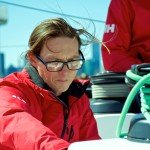
The first couple of days were about adjusting to life on board and making sure we were comfortable that all the boat’s systems were performing correctly. With some rough weather greeting us as we entered the Pacific, we had to shorten sail and hunker down for a bit. As we got off the coast of California, the weather improved and we began to explore the potential of this boat.
This tour was always about more than a delivery, it’s an opportunity to develop skills while always thinking about how these maneuvers would be done when short handed. When we were going upwind, we got a lot of practise reefing the mainsail, and developed a tack line system to make this easily done from the cockpit. Lately, with the wind from behind, we’ve deployed and retrieved all our downwind sails multiple times.
Personally, it has been a tiring first week at sea as there has been so much to do — from verifying all the boat systems to supervising the team through maneuvers. Attention to detail is so important, and with the loads this high, any missed step could have significant consequences. The team is learning fast but it is my job to make sure it is all done safely.
Over the past 24 hours, we’ve had winds gusting to 30 knots and boat speeds up to 20 knots. This has allowed us to catch up our schedule after a slow start. It looks like these conditions should only last another 24 hours before becoming quite light and variable along the coast of Mexico. – EH
Week 2:
Since leaving California behind the wind hasn’t been cooperative, with a lot of light and variable winds down the coast of Mexico. Our route took us pretty far offshore looking for what wind was to be had, and in doing so we passed by a remote island group called the Islas Revillagigedo. This was the first glimpse of land we had seen for some time.
Apparently there is great scuba diving there, but all we saw was a super trawler scooping up what fish was there. As we got further south, the biggest challenge became dealing with the heat — with temperatures in the Nav station regularly peaking at 42C by noon, and what little shade to be had on deck saw all five of us huddled under its protection.
It soon became apparent that with all the motoring we had to do, we would have to pull in to refuel before reaching Panama. Acapulco was the natural choice for a refuel with a deep harbour, good facilities, and not far off the direct track. We arrived at the Club de Yates de Acapulco at around midnight so had to wait until the next morning to clear into the country.
Having a fresh shower and a cooked breakfast was such a treat after a couple weeks at sea. The paperwork to clear into Mexico is laborious and took most of the day. I was then given the bad news that the fuel dock had broken down. Nothing to do but go for a swim in the club’s pool while we waited to see if they could get if fixed before the end of the day and the start of the weekend. Fortunately by 5pm the problem had been fixed and by 6pm we were refueled and on our way again. A short 18 hour pit stop, but no time to delay and explore, we’re on a tight schedule to Panama. – EH
Week 3:
Acapulco has been left behind and we’re on the final 1300 mile leg to Panama. Our fuel tanks have been pressed, for which we are grateful for as we’ve already been a couple days under motor and winds in this part of the world are unreliable. We’ve lost the moon that we had been enjoying since the start of this voyage, and now the nights are very dark. It’s been rather hazy and humid so that even the stars can be difficult to make out. Nights remain the most pleasant time of day.
We’ve resorted to doing most of our boat work in the time between dinner and sunset when the temperature is manageable. The wildlife has been particularly interesting. We seem to have passed through a sea turtle migratory route and counted 42 turtles in one day. We’re well offshore yet both a dove and a sparrow landed on board. The dove left us after a day but sadly the sparrow didn’t make it and was given a sea burial.
O Canada has been receiving a lot of care from us and we’ve been rewarded with very few issues. The other day the mountsd for our primary alternator sheared off and we’ve had to resort to charging the house battery bank in parallel with the start battery using the smaller secondary alternator. This has more than doubled our charging time but this has yet to be an issue as we’ve had regular motoring periods as the wind fails. Yesterday while remaining glassy calm the waves started building from the SE showing us that something was up ahead, and today we are beating into 20-25 knots, something we haven’t seen since leaving BC. It’s definitely wet on deck and the challenge now is how to keep from brining that wet down below. – EH
Week 4
We were so happy to be finally out of the Panama Canal. You have to accept that you have no control and if you’re on a tight deadline, this is easier said than done. We did enjoy the hospitality of Flamenco Marina, there are a wide choice of restaurants, which after a month at sea was a luxury.
We made good use of the wifi, topped up our diesel, and bought some fresh provisions. Last time I was in Panama we only stopped overnight and I never made it out of the marina. This time I was determined to at least get into old town Panama and have a look around. After that first night, we were on constant standby to go through the canal. We’d be sitting at the restaurant finishing our dinner at 10pm when the agent would show up to inform us our transit had been moved up to 6am the next morning.
The first time this happened we awoke at 4am to move around to the pilot pickup point for 5am, just to be told that out transit had been canceled. The second time this happened we were justly skeptical but the pilot did arrive at 6am and we were on our way through the canal.
Things were looking up as we made it through the three inbound locks heading into the lake system. At 10:30 the pilot informed us that he will be getting off here and we’ll have to anchor for the night, no reason given and another 24-hour delay. We spent an interesting night swinging at anchor just outside the shipping lane, watching the large cargo ships passing by a few metres away and beating off the insects.
Our second pilot the next day was terrific and got us into the outbound lock ahead of schedule. This proved to be a godsend as the cargo ship behind us that we were scheduled to transit with broke down and was eventually towed backward, back into the canal. That could have cost us another day in the canal. It was a momentous moment for Canadian Ocean Racing when we descended the final lock into the Atlantic. It was only three months earlier that we began bringing O Canada out of dry storage, and one month and 4000 miles to get her here. O Canada was back in the Atlantic for the first time since the 2008 Vendee Globe. -EH
Week 5
I would be a popular man if I could discover a way of getting out of the Caribbean without beating to windward. Alas, it was upwind from the moment departing Panama until we cleared the Bahamas into the Atlantic. The quickest route is often to tack eastward towards Cartagena on the Colombian coast and the ride the lifting wind all the way to Jamaica. With 35 knots blowing to the east that would have made for a rough ride, so we headed north and resigned ourselves to tacking our way up the western Caribbean, avoiding the many reefs that lie of the Nicaragua rise.
It was a wet ride with white water continuously coming over the bow. All hatches were kept dogged down, yet water still managed to find its way down below. It is not the most comfortable ride and can be quite tiring with sleep being hard to come by as the boat lurches over each wave. As we rounded the eastern tip of Jamaica, Morgen and I spent a moment reminiscing about our Clipper Race experience in these waters the previous year, where we battled Great Britain to the finish, taking victory by a mere 31 seconds.
I can’t explain exactly why, but for me the Windward Passage between Cuba and Haiti ranks among the iconic waterways that is a draw to sailors. And on my second passage, I was again captivated, although next time I’d like to go the other way under spinnaker rather than beating through it. Last night we sailed through the islands of the Bahamas and today we’re out into the Atlantic proper, with our course set for Halifax. It’s hard to imagine that we’ll be back in Canada before we know it, will have sailed 7000 miles and sailed around North America. -EH
Week 6
We are on the final stretch up the Atlantic and should be in Halifax on Saturday. It’s hard to believe that this phase of the journey is almost at an end, that we’ve sailed nearly 7000 miles around North America. But I’ll save the recap and reminiscing for later. We have had an eventful past 24 hours.
Our first unpleasant surprise was with our watermaker, it’s water output became too high a salinity to be potable. My immediate reaction was to verify how much potable water we have left and our timing to Halifax. Since we have enough fresh water for the remainder of the trip, it’s repair is not immediately crucial. There is nothing in the manual about this type of failure so a call to the service department would be prudent, although we suspect a failed o-ring is to blame.
Next this morning, the mainsail came rapidly and unexpectedly down onto the deck. We’ve been having chronic issues with halyard chafe so our first assumption was that it had chafed through despite our regular inspection. It turned out to be more surprising in that the big stainless steel ring that connects the headboard to the batten car had failed.
After some time with a hacksaw and file we removed the broken pieced, lashed the headboard back on and re-hoisted the sail. I wouldn’t have expected that failure, but I think we may want to replace it with a soft dyneema loop instead. One positive is that our lazy jack system contained the sail in a nearly perfect flake.
I won’t yet say lastly, as the day isn’t out, but the subsequent thing to go wrong was a rod supporting the primary alternator failed, so we are back to charging the house batteries in parallel with the start battery off the smaller alternator. This is the second time we’ve had a failure with the alternator supports, the last time was in the Pacific when the main bracket sheared off, and which we had repaired in Panama. The 150 amp primary alternator is quite heavy and it seems the mountings need to be reconsidered. Luckily we have a recently graduated naval engineer on board in Liam Johnston, that we can put on the task. We’re all looking forward to our arrival in Halifax, and to begin tackling the growing job list that can’t be done at sea. Probably no one is looking forward to it more than Daniel Gaw, who will be coming home with a lot of new stories to share. -EH
Week 7
We’re very happy to be back on land, having accomplished our 7000 mile journey from Vancouver. We are being treated very well by the Royal Nova Scotia Yacht Squadron, who are hosting our stopover. We were fortunate to get here in good time and have a week to prepare for the next leg through the St. Lawrence seaway to Toronto.
Our arrival was in the pouring rain and fog and we were wet through. The next day the sun came out and Halifax was showing at its best. A perfect day to pull all the gear off the boat to dry and complete our deep clean. Maintenance is progressing; we’ve repaired the watermaker, which unfortunately required the membrane, new in Vancouver, to be replaced. The alternator bracket is being re-welded and we are confident we’ll be ready to depart on Sunday, maybe even with time to visit Halifax a bit. I’m enjoying being back here, catching up with old friends and frequenting familiar haunts.
On Friday evening we’ll be taking part in the Squadron’s annual dock party, and on the weekend we’re taking the youth team out for sails on board O Canada. Both events will no doubt be a lot of fun and a nice way to end our stay here. -EH
Week 8
So here we are in the small fishing port of Riviere au Renard on the Gaspe Peninsula. A result of our engine failing to start. Not only do we rely on our engine for axillary propulsion, but is the sole source of charging our batteries.
In the steep following seas crossing the Gulf of St Lawrence, water was forced up the exhaust hose and into the engine cylinders — not an ideal scenario. Now that we know the problem, we are working with the very friendly local mechanics to solve, hopefully by tomorrow. I am very glad I paid attention in French class as it is turning out very helpful. I haven’t had the opportunity to practise recently, but it is slowly coming back.
What’s proving hard is switching back and forth between the two languages, and I’ve taken to giving commands to the team in French and getting a lot of blank stares in response. Up until this unscheduled delay, we were making great progress since our departure from Halifax. I had never seen weather so nice in Nova Scotia as we reached away from Halifax with a warm breeze blowing of the lands as we reached along the coast.
In under 24 hours we were transiting the Canso Canal between mainland Nova Scotia and Cape Breton. The breeze freshened as we past by PEI and we crossed the 200 miles of the Gulf of St Lawrence in under 12 hours, at which point we encountered our engine troubles and had to request a tow from our friendly neighborhood Coast Guard. Many thanks to the crew of the Cap D’Espoir.
Halifax was a wonderful stopover and we couldn’t have felt more welcomed. I enjoyed catching up with many friends that I hadn’t seen in a very long time. On the weekend before we departed with took the local youth race team out sailing. It was great fun and I hope they enjoyed it as much as we did. It reminded me when I was young and the catamaran ENZA New Zealand came to Vancouver and invited us out for a sail. Hopefully this unexpected pit stop will soon be behind us and we can get back on schedule for Toronto. -EH
Week 9
This final leg of the journey has been a very different experience for me. I am used to sailing on the open ocean, and it is so foreign to me to be able to practically touch either shore. Traveling up the river isn’t without it’s challenges, there have been strong currents that have brought the boat to a near standstill, wrecking havoc on my predicted arrival times.
We’ve also entered an area where thunderstorms are frequent. I’ve been trained to keep a safe distance from a lee shore, yet here we’re constantly within metres of a lee shore. On a boat with an undersized engine and plenty of windage, I am being kept on my toes and catching naps when I can.
From Quebec City to Montreal we had a escort rib to give us a tow through the most challenging stretches. It was a great help and was necessary, yet meant I had two vessels’ fuel to monitor and conserve. The rib was dropped off in Montreal as they are not allowed to go through the locks with us. We’ve now gone through six of the seven lock in the St Lawrence Seaway. After going through the mammoth Panama canal, these locks are no less impressive, with a vertical lift much greater than in Panama.
From Quebec City through to Montreal was very picturesque, with many quaint villages dominated by towering church spires. We’ve since moved into cottage country, passing by the backyards of families enjoying this summer weather, and exchanging waves with all the pleasure craft on the water. It was a bit embarrassing to be on this amazing racing machine and yet being passed by a leisurely kayaker as we battled head winds and current in the main channel under motor. We’re not showing ourselves at our best, but still getting plenty of attention as we go past.
We’re heading to our final destination of Toronto for this tour around North America. It’s been a long journey to get this far, and I can’t tell you how much we are all looking forward to entering the open water of Lake Ontario and stretching our wings again, being around the excitement of the Pan Am Games, and taking part in the Lake Ontario 300 race. -EH
Blow-by-blow
Daily highlights from #CORTOUR
Day 1
Today we leave Vancouver! Meet the 1st AOA team that will take #open60 O Canada to Toronto http://t.co/h9RIOG8xbc #CORTOUR — CanadianOceanRacing (@OceanRacers) April 22, 2015
Day 2
First morning at sea finds us in the Strait of Juan de Fuca with a 50mile run to the open ocean. The night was calm and uneventful. #cortour — Eric Holden (@ericsholden) April 23, 2015
Day 3
A cold front with many squalls and a confused sea state has made for a long and interesting first night in the Pacific. #cortour — Eric Holden (@ericsholden) April 24, 2015
Day 4
Out of fresh meat. Having some freeze dried chicken and @RAenergy with dinner tonight #log #CORTour http://t.co/vON4J7CYWg — CanadianOceanRacing (@OceanRacers) April 25, 2015
Day 5
Light winds made for slow progress and a good opportunity for boat work. New reef tack system ready for testing. Headwinds now. #cortour — Eric Holden (@ericsholden) April 26, 2015
Day 6
4am #log. Misty night but blasting along the Californian coast. Nights are getting warmer! #CORTour http://t.co/K8K8fK80zF — CanadianOceanRacing (@OceanRacers) April 27, 2015
Day 7
Moonlight night, 16 degrees on deck, covered 60nm in last 6h, still flying FC0, Liam on the helm #log #CORTour — CanadianOceanRacing (@OceanRacers) April 28, 2015
Day 8
Liam just smashed the record, we have broke 20kt! #nostopsurfin #CORTour #lifeonboard — CanadianOceanRacing (@OceanRacers) April 29, 2015
